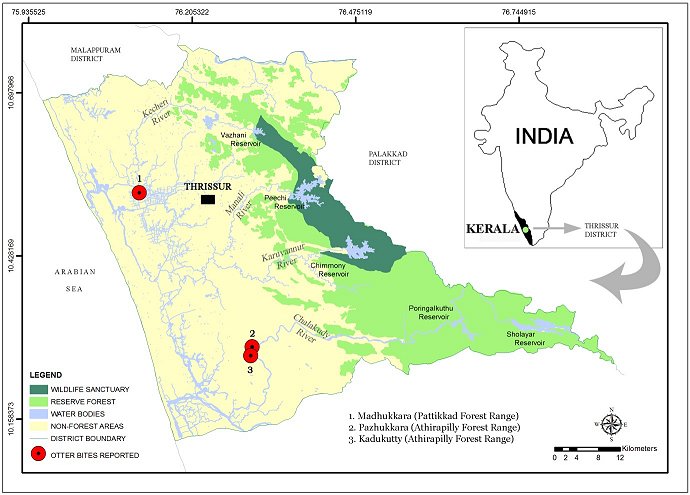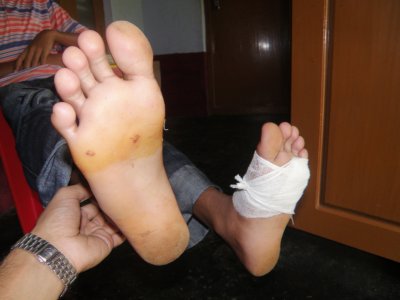IUCN/SSC Otter Specialist Group Bulletin

©IUCN/SCC Otter Specialist Group
Volume 35 Issue 1 (January 2018)
Citation: Govind, SK and Jayson, EA (2018). Attack of Otter on Humans in Thrissur, Kerala, India. IUCN Otter Spec. Group Bull. 35 (1): 57 - 61
Attack of Otter on Humans in Thrissur, Kerala, India
Suresh K. Govind1* and E.A. Jayson1
1 Wildlife Department, Kerala Forest Research Institute, Peechi - 680 653, Thrissur, Kerala, India e-mail - sureshavinissery@gmail.com


|
| (received 5th February 2015, accepted 15th November 2017) |
| Download PDF (886 KB) |
| Abstract: Human-otter conflict is a rare phenomenon. Otters attacking humans have been reported from the American Continents and the Indian sub-continent. Smooth-coated otter (Lutrogale perspicillata) attacking humans is reported from Thrissur, Kerala, India, recorded during a detailed study on human-wildlife conflict from April 2009 to March 2012. Focus group discussion was carried out with the local people and the details of ex-gratia to the victims were collected from the records of Kerala Forest and Wildlife Department. Three people were attacked by smooth-coated otter; a human casualty was reported. All the attacks were at dawn and dusk. Ex-gratia was immediately sanctioned to the victims by the Kerala Forest and Wildlife Department. The otters were in groups when attacking humans. Two incidents occurred during the breeding season (August to November), and the remaining incident was in June 2011. Smooth-coated otterss attacked three people in Thrissur, Kerala, India and the reason for this aggressive behaviour is territorial. . |
| Keywords: Smooth-coated otter, human-otter conflict, Kerala, India |
| Française | Español |
INTRODUCTION
Three species of otters inhabit India, and the Smooth-coated otter (Lutrogale perspicillata) is common in Kerala (Menon, 2014) and mainly feeds on fishes (Prater, 1965). Bite attacks of otters on humans were reported from North America (Lontra canadensis) (Potter et al., 2007) and South America (Pteronura brasiliensis) (McTurk and Spelman, 2005). Several anecdotal incidents of human-otter (Lontra canadensis) conflicts and rabies infection within the species were reported by Belanger et al. (2011). An attack by Smooth-coated otter at Tungabadra, India was reported by Nagulu (1992). In this paper, Smooth-coated otter (Lutrogale perspicillata) attacking people in Thrissur District, Kerala, India is reported. Hunting of smooth-coated otter is illegal as this species is protected by the Wildlife Protection Act of India.
Study area
Thrissur District (10°46’ to 10°7’ N and 75°57’ to 76°55’ E) is in the central part of Kerala State, India, spanning an area of about 3,032 km2. The District has a tropical humid climate and plentiful seasonal rainfall (2500 mm to 3500 mm). The study area is comprised of 11 Forest Ranges within three Forest Divisions namely Thrissur (210.64 km2), Chalakudy (279.71 km2) and Vazhachal (413.94 km2) and three Wildlife Sanctuaries (213.44 km2). Chalakudy, Karuvannur, Manali and Kecheri Rivers convey water to the wetlands in the District.
METHODOLOGY
Incidents of otter-bite were recorded as a part of the detailed study on human-wildlife conflict in Kerala from April 2009 to March 2012. The conflict sites were visited and the victims of attack were queried at their home. Date and time of attack and mode of attack were recorded. Focus group discussion was carried out with the local people. Twelve houses were surveyed (four houses from each area of otter attack), which were on average 143 m away from water-bodies. Details of ex-gratia claimed and provided were collected from the records of the Kerala Forest and Wildlife Department.
RESULTS
Three incidents of otter-bite (Lutrogale perspicillata) on humans were recorded during the period (Figure 1). One human death and one human injury were in Athirapilly Forest Range and the other injury was in Pattikkad Forest Range (Table 1). Injured persons were given an amount of Rs. 500/- each (One US Dollar = Rs. 50/-) and Rs. 100000/- was sanctioned to the deceased person's family by the Kerala Forest and Wildlife Department. Rabies vaccination was also administered to the injured persons. As the bites were unexpected, the victims could not count the number of otters in each group. Spraints were seen on the banks of river by the local people (n=12). They could not determine the sex of the Smooth-coated otter when the species was seen on the river banks.

|
| Figure 1. Locations of otter-bite on humans in Thrissur District, Kerala. (click for larger version) |
| Table 1: Human-otter interaction in Thrissur District, Kerala. | ||||
| Date (Time) | Forest Range (Forest Division) | Latitude & Longitude | Age & Sex of Victim | Mode of attack |
| 02-09-2010 (08.00 hrs) | Athirapilly (Vazhachal) |
10°5'47.9"N & 76°18'9.72"E |
52, Male | A veteran fisherman was attacked by otters, while he was swimming in the Chalakudy River to fix a fish net across the river at Kadukutty. When he reached the middle portion of the river, otters attacked him and dragged him for 500 meters along with the flow of river. His son on the bank saw the attack, but he was helpless to attempt any rescue operation. The body was recovered by local people and the death of the person was confirmed in the hospital; the cause was reported as drowning. Otter bites were clearly visible on the victim's body. |
| 02-06-2011 (17.00 hrs) | Pattikkad (Thrissur) | 10°31'57.4"N & 76°7'7.7"E | 9, Male | At Madhukkara, a boy was attacked while he was playing in the shallow water near the house. Biting was on his left leg. |
| 14-09-2011 (17.30 hrs) | Athirapilly (Vazhachal) |
10°16'40.6"N & 76°18'17.7"E | 13, Male | At Pazhukkara, otters bit on both legs of the victim while he was crossing the canal along with his friends (Figure 2). |

|
| Figure 2. Smooth-coated otter attack on legs (Athirapilly Forest Range), Kerala (click for larger version) |
DISCUSSION
Attacks of smooth-coated otters on humans were recorded during dawn and dusk, and in all the incidents, the otters were in groups. Fish is the main food of this species (Prater, 1965; Anoop and Hussain, 2005) and it was reported that fish are abundant in the rivers and backwaters of the District (Kadhar, 1993). Human fatality due to attack by smooth-coated otter was reported for the first time in Kerala. A human death due to a Smooth-coated otter had been reported earlier at Tungabadra, India by Nagulu (1992). Fishermen were killed in both incidents. It is assumed that otters attacked the fisherman because their pups were trapped in the net, as happened at Tungabadra. Otters bit the legs of both boys without any apparent provocation and the signs of attack were clearly visible (Figure 2). Studies in North America pointed out that otters are very aggressive when their pups are accompanying them (Chapman and Feldhamer, 1982; Shannon, 1989; Kruuk, 2006). In the National Chambal Sanctuary, India, the breeding season of Smooth-coated otters was reported to be between August and November (Hussain, 1996). Two of these incidents were recorded in the district during the same period and the remaining incident occurred two months before the mating period (Table 1). It is therefore likely that territorial incursion by humans was the trigger for all three events.
Acknowledgements: We are thankful to Dr. K.V. Sankaran (Former Director), Kerala Forest Research Institute, Peechi, Kerala, India and the Forest officials for giving support to the study.
REFERENCES
Anoop, K.R., Hussain, S.A. (2005). Food and feeding habits of smooth‐coated otters (Lutra perspicillata) and their significance to the fish population of Kerala, India. J. Zool. 266: 15-23.
Belanger, M., Clough, N., Askin, N., Tan, L., Wittnich, C. (2011). A review of violent or fatal otter attacks. IUCN Otter Spec. Group Bull. 28: 11-16.
Chapman, J.A., Feldhamer, G.A. (1982). Wild mammals of North America: Biology, management, and economics. Baltimore: Johns Hopkins University Press.
Hussain, S.A. (1996). Group size, group structure and breeding in smooth-coated otter Lutra perspicillata Geoffroy in National Chambal Sanctuary. Mammalia 60: 289-297.
Kadhar, A.P.B. (1993). Studies on the fish and fisheries of inland waters of Thrissur District. Ph.D. Thesis. University of Calicut. Kerala.
Kruuk, H. (2006). Otters: Ecology, behaviour and conservation. Oxford University Press.
McTurk, D., Spelman, L. (2005). Hand-rearing and rehabilitation of orphaned wild giant otters, Pteronura brasiliensis, on the Rupununi river, Guyana, South America. Zoo Biol. 24: 153-167.
Menon, V. (2014). Indian mammals - A field guide. Hachette Book Publishing India Pvt. Ltd., India.
Nagulu, V. (1992). News from India. IUCN Otter Spec. Group Bull. 7: 41-42.
Potter, T.M., Hanna, J.A., Freer, L. (2007). Human North American river otter (Lontra canadensis) attack. Wild. Environ. Med. 18: 41-44.
Prater, S.H. (1965). The Book of Indian Animals. 2nd (rev.) Eds. Bombay Natural History Society. Bombay.
Shannon, J.S. (1989). Social Organization and Behavioural Ontogeny of Otters (Lutra canadensis) in a coastal habitat in Northern California. IUCN Otter Spec.Group Bull. 4: 8-13.
Résumé : Des Loutres s’Attaquent à l’Homme à Thrissur, au Kerala, en Inde
Les conflits entre l’homme et la loutre sont un phénomène rare. L’attaque de personnes par des loutres a été rapportée sur le continent américain ainsi que sur le sous-continent indien. L’attaque de personnes par la loutre à pelage lisse (Lutrogale perpicillata) a été signalée à Thrissur, au Kérala en Inde. Cette attaque a eu lieu durant une étude détaillée sur les conflits entre l’homme et la vie sauvage, d’avril 2009 à mars 2012. Un groupe de discussion a été mis en place avec l’aide de la population locale et les détails des dédommagements aux victimes ont été rassemblés à partir des données du Département de la Foret et de la Vie sauvage du Kerala. Trois personnes ont été attaquées par des loutres à pelage lisse dont une a été blessée.
Toutes les attaques se sont produites au crépuscule et à l’aube. Un dédommagement a été immédiatement accordé aux victimes par le département de la Forêt et de la Vie sauvage du Kerala. Les loutres étaient en groupes lorsqu’elles ont attaqué des personnes. Deux incidents se sont produits durant la période de reproduction (août et novembre). Le dernier incident date de juin 2012. Des loutres à pelage lisse ont attaqué 3 personnes à Thrissur, au Kerala en Inde. La raison de ce comportement agressif est dû à leur tempérament territorial.
Revenez au dessus
Resumen: Ataque de Nutrias a Humanos en Thrissur, Kerala, India
El conflicto humanos-nutrias es un fenómeno raro. Se han reportado nutrias atacando a humanos en los continentes Americanos y en el sub-continente Indio. Reportamos a la nutria lisa (Lutrogale perspicillata) atacando a personas en Thrissur, Kerala, India, lo que fue registrado durante un estudio detallado del conflicto humanos-fauna desde Abril de 2009 hasta Marzo de 2012. Se llevó a cabo una discusión de focus-group con las personas locales, y se colectaron detalles de las compensaciones a las víctimas a partir de los registros del Departamento de Bosques y Vida Silvestre de Kerala. Fueron atacadas tres personas por nutrias lisas, informándose de un caso fatal. Todos los ataques fueron durante el amanecer y el atardecer. La compensación fue inmediatamente otorgada a las víctimas por el Departamento de Bosques y Vida Silvestre de Kerala. Cuando se produjeron los ataques, las nutrias estaban en grupo. Dos incidentes ocurrieron durante la estación reproductiva (Agosto a Noviembre) y el otro en Junio de 2011. La nutria lisa atacó a tres personas en Thrissur, Kerala, India y la razón de este comportamiento agresivo es su naturaleza territorial.
Vuelva a la tapa